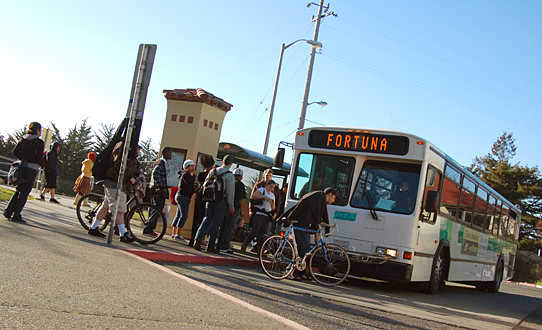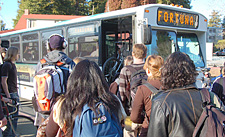
At Humboldt State, it’s 10:07 a.m. and the bus has just let off at Library Circle. Heading down to HSU’s other main stop, at 14th and B streets, already cars are lined up 15-deep waiting to get into the parking lot. The four-way stop is busy and, by the looks of it, so will parking enforcement personnel be as they hand out the 900-plus parking citations they write each month.
Looking at aerial video of HSU it becomes clear how few parking spaces are on campus. For the 7,550 students at HSU, a well-known quote from emeritus Journalism professor Maclyn McClary is undeniable: “It’s not a parking permit, it’s a hunting license for a rare and elusive beast.”
And how elusive that beast is. According to Parking And Commuting Services, in June, 2007, there were 2086 total parking spaces on campus, with 70% of those for student use. At 5.2 students for each parking spot, even the most car pool-friendly students will have trouble finding five people to share a ride with. Bicycling and walking are great alternatives, but as the weather turns gray, people like the conveniences of cars. With Humboldt State’s student population growing each year numbers like these had to add up to a big change.

Students find a solution
Parking is an issue at any college campus. Beyond parking your vehicle are the issues of paying for gas, ozone emissions and reliance on limited energy supplies. Perhaps most salient, is the fact that, as HSU’s transportation club points out, for many of us transportation is the second greatest expense after housing costs. In 2004 a movement began on campus when Wildlife graduate student Chris Rall sought to alleviate this and started on the path toward the Jack Pass.
Rall, and Green Wheels (then known as the Alternative Transportation Club), had seen the University of Washington’s universal bus pass system keep parking demand stable even when the university had grown by 19%. Clearly students, staff and faculty were using the bus passes — and now Rall and the club were determined to bring a similar pass to HSU.
Fast forward three years through meetings, committees, trips to the Chancellor’s office and student votes, and by the 2007 fall semester, a county-wide bus pass was in place. Money comes in through the Instructionally Related Activities fee, with $15 of each student’s money going to the Jack Pass program.
Already, a marked increase in ridership has been noticed, at least anecdotally. According to Green Wheels’ newsletter, Community Wheel, parking permit sales are down and in October of 2007, the Redwood Transit Service announced a 30% overall increase in ridership over the year before. Since existing data doesn’t account for HSU ridership, there is no baseline for more accurately judging the increase, but to the passengers riding the standing-room only bus home at 5 p.m, the boost in ridership is clear.
From an environmental protection standpoint, the fact that more people are riding the bus couldn’t be better news. If Parking Services sold 1165 parking passes last year and it’s assumed, for the sake of illustration, that at least half of those permits were to people commuting about 15 miles a day, then HSU has 582 people driving 8730 miles to get here. Anyone can use Parking Services Commuter Savings Calculator to compute that nixing those 15-mile round trips adds up to a yearly savings of over 1400 pounds of C02 per car, not to mention other startling figures that show up.
And while riders are feeling packed in, some riders can’t wait to get their own Jack Pass. College of the Redwoods student, and Arcata resident, Hannah Earhart wants to transfer to Humboldt State to study business once she’s done with general education. For Hannah, spending $50 a month on bus tickets to CR adds up. “That’s $50 for rent or for food or for books. That’s $50 I don’t have.”
Catching the bus at the 12:11 Bay Shore Mall stop, it’s relatively sparse. Twenty-three people and one bike make up the bus’ cargo and the bus is making good time. New fare boxes were installed last Monday and some riders are having trouble with the Coke machine-like dollar bill slot. This has been making the bus a little late, but not for people with the Jack Pass. This bus is mostly HSU students on their way to class and they’ve cruised past the driver with a show of their student I.D. and a nod of the head. By the time the bus is back on the 101 north a few people are standing in the back and the bus’ bike racks are full.
These riders have discovered something that UPD Police Chief Tom Dewey likes to point out, most recently in the Lumberjack’s article on the parking crunch: With the Jack Pass in place, the whole county is becoming a giant park and ride. The Jack Pass is in its infancy and there will be scheduling adjustments and buses added until things run as smoothly as possible. Until then, ridership is up, CO2 is down and, perhaps most importantly, for Jack Pass users getting to class in time doesn’t mean circling the parking lot for the umpteenth time before finally giving up and parking next to Safeway.